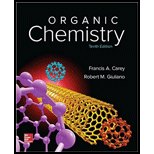
Concept explainers
Show by a series of equations how could synthesize each of the following compounds from the indicated starting material and any necessary organic or inorganic reagents:
(a)
(b)
(c)
(d)
(e)

(f)  from
from 
(g)
(h)
(i)
Interpretation:
The way in which each of the given compounds can be synthesized from the indicated starting material and any necessary organic or inorganic reagents is to be shown by using a series of equations.
Concept Introduction:
Hydroboration reaction is a two-step reaction that involves conversion of an alkene into alcohol. This type of reaction follows anti-Markovnikov's rule.In acid-catalyzed dehydration, a saturated compound is converted to an unsaturated compound with the removal of a water molecule in the presence of an acid catalyst.
Grignard reagent is prepared by the reaction of alkyl or aryl bromide with magnesium metal in the presence of ether.
Thionyl chloride
Lithium aluminium hydride is a strong reducing agent. The reduction of carboxylic acid by
Oxidation reaction involves increase in the
Answer to Problem 18P
Solution:
a)The reaction that shows the preparation of

b)The reaction that shows the preparation of

c)The reaction that shows the preparation of

d)The reaction that shows the preparation of

e) The reaction that shows the preparation of

f) The reaction that shows the preparation of

g) The reaction that shows the preparation of

h) The reaction that shows the preparation of

i) The reaction that shows the preparation of

Explanation of Solution
a)
In the synthesis of
Thus, the reaction that shows the preparation of

b)
The reaction that shows the preparation of

The first step of the required synthesis is the reaction of acid with the given alcohol. This step is the dehydration of alcohol. In the next step, hydroboration of alkene is done, which is then followed by hydrolysis. This results in the formation of
Thus, the required acid is synthesized.
c)
In the required synthesis, the first step is the reaction of the given alcohol with

d)
In this synthesis, the first step is the reaction of the given carboxylic acid with thionyl chloride to form acyl chloride. In the next step, acyl chloride reacts with diazomethane to form diazoketones. In the last step of the synthesis reaction, the diazoketones give the final product in the presence of metal catalyst and water. The given reaction is an example of Arndt-Eistert synthesis.

Therefore, the required product is synthesized.
e) 
In the required synthesis, the first step is the hydrolysis of

Therefore, the required product is synthesized.
f) 
The reaction of

Therefore, the required product is synthesized.
g)
In the required synthesis, the first step is the nitration of

Thus, the required product was synthesized.
h)
In the synthesis of

Therefore, the given compound was synthesized.
i)
Sodium amide is a strong base and acts as s strong nucleophile.The reaction that shows the preparation of

In the above synthesis, the first step is the reaction of
Want to see more full solutions like this?
Chapter 19 Solutions
ORGANIC CHEMISTRY (LL)-W/SOLN.>CUSTOM<
- Using reaction free energy to predict equilibrium composition Consider the following equilibrium: 2NO2 (g) = N2O4(g) AGº = -5.4 kJ Now suppose a reaction vessel is filled with 4.53 atm of dinitrogen tetroxide (N2O4) at 279. °C. Answer the following questions about this system: Under these conditions, will the pressure of N2O4 tend to rise or fall? Is it possible to reverse this tendency by adding NO2? In other words, if you said the pressure of N2O4 will tend to rise, can that be changed to a tendency to fall by adding NO2? Similarly, if you said the pressure of N2O4 will tend to fall, can that be changed to a tendency to '2' rise by adding NO2? If you said the tendency can be reversed in the second question, calculate the minimum pressure of NO 2 needed to reverse it. Round your answer to 2 significant digits. 00 rise ☐ x10 fall yes no ☐ atm G Ar 1arrow_forwardWhy do we analyse salt?arrow_forwardCurved arrows are used to illustrate the flow of electrons. Using the provided starting and product structures, draw the curved electron-pushing arrows for the following reaction or mechanistic step(s). Be sure to account for all bond-breaking and bond-making steps. H H CH3OH, H+ H Select to Add Arrows H° 0:0 'H + Q HH ■ Select to Add Arrows CH3OH, H* H. H CH3OH, H+ HH ■ Select to Add Arrows i Please select a drawing or reagent from the question areaarrow_forward
- What are examples of analytical methods that can be used to analyse salt in tomato sauce?arrow_forwardA common alkene starting material is shown below. Predict the major product for each reaction. Use a dash or wedge bond to indicate the relative stereochemistry of substituents on asymmetric centers, where applicable. Ignore any inorganic byproducts H Šali OH H OH Select to Edit Select to Draw 1. BH3-THF 1. Hg(OAc)2, H2O =U= 2. H2O2, NaOH 2. NaBH4, NaOH + Please select a drawing or reagent from the question areaarrow_forwardWhat is the MOHR titration & AOAC method? What is it and how does it work? How can it be used to quantify salt in a sample?arrow_forward
- Predict the major products of this reaction. Cl₂ hv ? Draw only the major product or products in the drawing area below. If there's more than one major product, you can draw them in any arrangement you like. Be sure you use wedge and dash bonds if necessary, for example to distinguish between major products with different stereochemistry. If there will be no products because there will be no significant reaction, just check the box under the drawing area and leave it blank. Note for advanced students: you can ignore any products of repeated addition. Explanation Check Click and drag to start drawing a structure. 80 10 m 2025 McGraw Hill LLC. All Rights Reserved. Terms of Use | Privacy Center | Accessibility DII A F1 F2 F3 F4 F5 F6 F7 F8 EO F11arrow_forwardGiven a system with an anodic overpotential, the variation of η as a function of current density- at low fields is linear.- at higher fields, it follows Tafel's law.Calculate the range of current densities for which the overpotential has the same value when calculated for both cases (the maximum relative difference will be 5%, compared to the behavior for higher fields).arrow_forwardUsing reaction free energy to predict equilibrium composition Consider the following equilibrium: N2 (g) + 3H2 (g) = 2NH3 (g) AGº = -34. KJ Now suppose a reaction vessel is filled with 8.06 atm of nitrogen (N2) and 2.58 atm of ammonia (NH3) at 106. °C. Answer the following questions about this system: rise Under these conditions, will the pressure of N2 tend to rise or fall? ☐ x10 fall Is it possible to reverse this tendency by adding H₂? In other words, if you said the pressure of N2 will tend to rise, can that be changed to a tendency to fall by adding H2? Similarly, if you said the pressure of N will tend to fall, can that be changed to a tendency to rise by adding H₂? If you said the tendency can be reversed in the second question, calculate the minimum pressure of H₂ needed to reverse it. Round your answer to 2 significant digits. yes no ☐ atm Х ด ? olo 18 Ararrow_forward

 Organic ChemistryChemistryISBN:9781305580350Author:William H. Brown, Brent L. Iverson, Eric Anslyn, Christopher S. FootePublisher:Cengage Learning
Organic ChemistryChemistryISBN:9781305580350Author:William H. Brown, Brent L. Iverson, Eric Anslyn, Christopher S. FootePublisher:Cengage Learning

